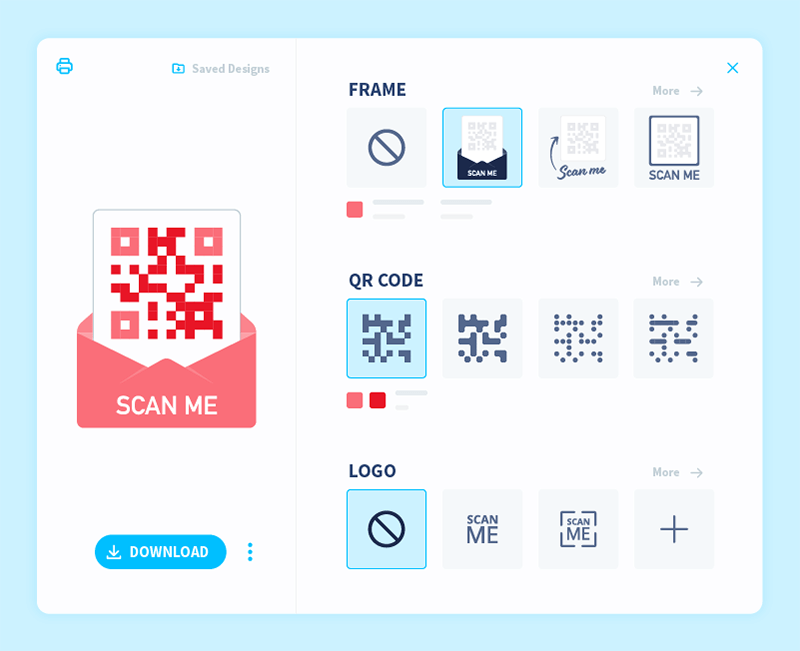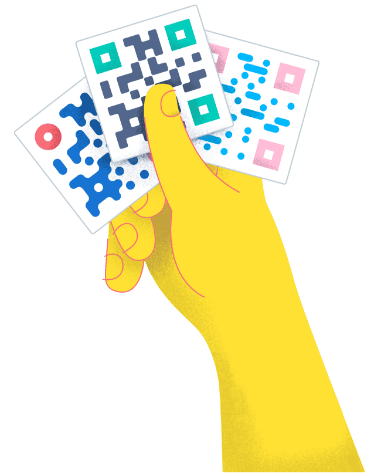- Best Practices ●
- COVID-19 ●
- Industry Trends ●
- Partners ●
- Product ●
5 Unique QR Code Design Ideas You Can Try
Creating Quick Response (QR) Codes can and should be far more than simple black-and-white pixels. As with many graphic design elements, a pleasing aesthetic balance is important for successful marketing campaigns.
Well-designed, creative QR Codes—contrasting harmonious colors, subtle gradients, and clean lines—increase user engagement and scan rates. When you design a QR Code thoughtfully, you create an eye-catching and memorable visual that draws the reader in, increasing the likelihood of them scanning it.
But how can you make your QR Code stand out from the rest? Below are five unique QR Code design ideas that you can try to make your marketing campaigns even more effective.
Why is it important to design custom QR Codes?
The graphic design you use will highly influence the success of your marketing strategy. With QR Code Generator, it’s possible to customize many aspects of all your individual QR Codes and save the designs as templates for later use. Here, we’ve outlined some of the major advantages of QR Code design.
Stand out from the crowd
Original QR Codes look more or less the same: a box with black-and-white squares. But nowadays, they can be so much more than that when given some graphic design oomph. The features of QR Code Generator PRO allow you to choose custom frames and colors—and you even have the ability to include a CTA (call to action).
Using these elements, you can add a touch of your brand personality to the QR Code. When compared to the look of the original QR Code design, a customized QR Code with designs is likely to be scanned more often.

Better brand recognition and awareness
When you design QR Codes with your brand specifications, they increase brand awareness. Think of the concept of a logo. It’s something people remember because they see it repeatedly and then connect it to a specific company. This fosters customer retention because after they make a purchase, they’re more likely to remember that brand.
The same concept applies to QR Codes. Using your brand colors, fonts, and other elements that speak about your brand in the QR Code design creates a memorable and cohesive experience for the customer. You can even include the logo inside them for a good double dose of branding. Custom QR Codes that align with your brand identity increase initial awareness and recognition.
Tracking and analytics
A big perk when designing individual QR Codes is that you can save your designs as templates. Not only this, but if you use a Dynamic QR Code, you can use QR Code tracking to see when, where, and how many times people scan it. Dynamic QR Codes enable you to update the content behind your code without reprinting or redesigning it. QR Code Generator PRO offers advanced tracking and analytics tools that allow you to monitor and analyze the performance of your QR Codes in real time. If you aim to find out which types of QR Codes bring the best results, you can test different designs to see which ones work best.
Improved user experience
The other thing to keep in mind is to make sure that the aesthetics are well-balanced. The QR Code always needs to be readable among the designs of the rest of the material surrounding it. Balance readability with graphics so your QR Code remains scannable. The sections below explore how to do this in more depth.
5 QR Code design ideas to inspire you
Designing a unique and eye-catching QR Code can sometimes prove to be challenging. To help you get started, here are five QR Code ideas that you can try to make your QR Codes stand out and increase engagement:
1. Brand colors and a logo
Brand colors and logos are crucial elements of a brand’s identity. Incorporating them into your QR Code design not only adds a touch of familiarity but also increases recognition and recall among customers. For example, Starbucks uses its signature green color and logo in its QR Codes to maintain brand consistency and make them easily recognizable by its customers. Follow these creative ideas to include your brand colors and logo in your QR Code:
- Create a pixel art version of your logo to replace the center squares of your QR Code. QR Code Generator lets you strategically integrate your brand colors and logo into the QR Code design while maintaining scannability.
- Assign specific brand colors to different sections of the QR Code.
- Apply a transparent gradient of your brand colors over the entire QR Code to create a subtle yet effective design.
2. Frames and backgrounds
Frames and backgrounds add a creative touch to your QR Code design. They allow you to incorporate additional graphics or information without overcrowding the code. For instance, a retail store could use a QR Code with a frame of its latest product line to promote it in-store or on social media.
To effectively use frames and backgrounds in your QR Code design, follow these tips:
- Design a QR Code with a frame that reflects your brand or message. It could be a heart shape for a charity campaign or a festive frame for holiday promotions.
- Place the QR Code on a textured background, like wood grain or marble, that complements your brand aesthetic.
- Place the QR Code on a background featuring a brand-related pattern or image, such as a clothing brand using a QR Code with a background of its latest fashion collection.
3. Engaging calls to action (CTAs)
CTAs encourage customers to take action after scanning the QR Code. A CTA in your QR Code design can increase engagement and drive conversions. This could be anything from prompting customers to follow your social media accounts, sign up for a newsletter, or purchase.
To effectively use CTAs in your QR Code design:
- Focus on the user benefit by phrasing the CTA as a question: “Want Exclusive Deals? Scan Here” or “Curious About Our Menu? Scan Now.”
- Use time-sensitive language to create a sense of urgency: “Limited Time Offer: Scan and Save!” or “Last Chance to Get 50% Off! Scan Now!”
- Include a visual cue, like an arrow or pointing hand, to draw attention to the QR Code and CTA.
- Add a playful element by turning QR Code scanning into a mini-game or giving a reward for scanning, such as a discount code or freebie.
4. Themes or events
If you’re promoting a specific event or celebrating a holiday, incorporating themes or images related to it can add a fun and festive element to your QR Code design. For example, if you’re hosting a Halloween-themed sale, you could use a QR Code with a spooky background or frame to promote it.
Follow these tips to use themes or events in your QR Code design effectively:
- Choose a theme or event relevant to your business that will resonate with your target audience. Incorporate themed elements like colors, icons, or patterns into your QR Code design.
- Create unique QR Codes for specific events or promotions rather than standard QR Codes for all occasions. A restaurant could use a Thanksgiving-themed QR Code to offer a discount on a special holiday menu, for example.
- Develop a series of QR Codes that unlock different offers or discounts leading up to a big event to create customer anticipation and excitement.
5. 3D designs
3D designs offer a more immersive and interactive experience for customers. They use optical illusions to add depth and dimension to your QR Code, intriguing customers and encouraging them to scan.
To effectively use 3D designs in your QR Code:
- Utilize 3D design software to create a raised effect on certain parts of the QR Code. You can also engrave QR Codes on different materials, such as metal or wood, to add a tactile element.
- Combine the QR Code with augmented reality (AR) technology. When customers scan the code, they access an AR experience that overlays 3D elements on their physical surroundings. For instance, a furniture store could use an AR-enabled QR Code to show customers how a piece of furniture would look in their home.
Ensure the 3D design does not obstruct the QR Code’s scannability. Keep important elements, such as the CTA, within a clear and easily scannable area.
Tips for creating QR Code designs to increase engagement
Whatever design elements you choose to incorporate in your QR Code, follow these tips to ensure maximum engagement from customers:
Be careful with contrast
QR Code design should include a balance between colors that contrast so that the QR Code stands out, but it must also match the rest of the material. The focus should be to include your brand colors and then contrast them so a reader’s eye is brought to the QR Code. They might not even notice the QR Code if everything is the same color. If there’s too much color, the entire material design likely won’t match.
Contrast also means checking the background on which you will place your QR Code. Particularly if you are using QR Codes on print materials, make sure the QR Code still contrasts with the background—otherwise, it could become unreadable.
Don’t forget the quiet zone
All QR Codes contain a quiet zone. It’s a blank space that separates the QR Codes from the surrounding designs. When designing material around QR Codes, whether print or digital, make sure to keep this section in mind so that the edges don’t get blurred, which could make the QR Code unscannable.
Test your QR Code link
Making sure that all of your information is correct before printing is of the utmost importance. Especially if you’ve printed mass amounts of materials, the QR Code design itself, of course, can’t be changed. You can, however, help reduce the chance of disaster striking by using an editable Dynamic QR Code, in which you can update links and other content a user is directed to without changing the QR Code design itself. Alternatively, double-check the link by scanning it with different devices and QR Code scanners to ensure it works properly.
Use high-quality images or logos
You should print QR Code images and designs with high-quality images in mind. If your QR Code is too small or blurry, it could be that it is not scannable due to errors. The customization software from QR Code Generator enables you to use logos and images within the QR Code itself.
Keep the QR Code size in mind
Print materials, of course, come in a wide variety of sizes. There are big differences between the sizing of graphics on a billboard on the street versus on a small brochure at a conference. The same goes for a design on business cards at networking events versus banners at a convention, or even stickers at street festivals. Adapt the QR Code’s size according to the space available and the distance from which it will be scanned.
We recommend keeping the QR Code size relative to the size of the medium. For business cards or brochures, the QR Code should be much smaller than it would be on, say, a billboard, where it would need to take up a lot more real estate to be visible and readable from a distance. Test the scannability and readability of the QR Code at different sizes before finalizing the design.
Design your perfect QR Codes with QR Code Generator PRO
A custom QR Code design increases customer engagement and brand recognition. Incorporating your brand colors, logos, and high-quality images can make your QR Code stand out and attract more scans.
QR Code Generator PRO allows easy customization, tracking, and optimization of your QR Codes. With Dynamic QR Codes and customizable loading screens, you can easily update information without changing the design. Plus, you can track the performance of your QR Codes and make data-driven adjustments to improve their effectiveness.
Don’t settle for generic QR Code designs that blend in with the crowd. Design your perfect QR Codes with QR Code Generator PRO and elevate your marketing campaigns to the next level. Sign up today!






 Add custom colors, logos and frames.
Add custom colors, logos and frames.

